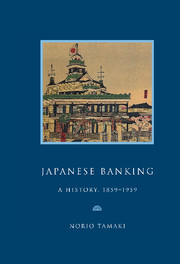Book contents
- Frontmatter
- Contents
- Preface
- Genealogy of leading Japanese banks, 1859–1959
- List of abbreviations
- Map
- Part I A bankrupt Shogunate, 1859–1868
- Part II The Meiji Restoration: monetary confusion and banking experiments, 1868–1881
- Part III Matsukata, the wizard of Japanese banking, 1881–1897; the Yokohama Specie Bank (1880) and the Bank of Japan (1882)
- Part IV The Japanese on the London money market, 1897–1911
- Part V War, the Japanese boom years, 1911–1919
- Historical background
- 17 Bank of Japan money supply, 1911–1919
- 18 The expansion of special banking, 1911–1919
- 19 Ordinary and savings banks, the search for strength, 1911–1919
- 20 Other financial sectors in the boom years, 1911–1919
- Part VI Crisis and the road to war, 1919–1937
- Part VII Complete commitment, struggle and defeat, 1937–1945
- Part VIII American ‘democratisation’ and the search for growth, 1945–1959
- An extraordinary century, 1859–1959
- Appendices
- Notes
- Bibliography
- Index
17 - Bank of Japan money supply, 1911–1919
Published online by Cambridge University Press: 03 February 2010
- Frontmatter
- Contents
- Preface
- Genealogy of leading Japanese banks, 1859–1959
- List of abbreviations
- Map
- Part I A bankrupt Shogunate, 1859–1868
- Part II The Meiji Restoration: monetary confusion and banking experiments, 1868–1881
- Part III Matsukata, the wizard of Japanese banking, 1881–1897; the Yokohama Specie Bank (1880) and the Bank of Japan (1882)
- Part IV The Japanese on the London money market, 1897–1911
- Part V War, the Japanese boom years, 1911–1919
- Historical background
- 17 Bank of Japan money supply, 1911–1919
- 18 The expansion of special banking, 1911–1919
- 19 Ordinary and savings banks, the search for strength, 1911–1919
- 20 Other financial sectors in the boom years, 1911–1919
- Part VI Crisis and the road to war, 1919–1937
- Part VII Complete commitment, struggle and defeat, 1937–1945
- Part VIII American ‘democratisation’ and the search for growth, 1945–1959
- An extraordinary century, 1859–1959
- Appendices
- Notes
- Bibliography
- Index
Summary
In spite of frequent large issues of national bonds on the western markets, primarily on London, specie shortages continued to worry the Japanese financial authorities. Since 1904 and the outbreak of the Russo-Japanese War, the Japanese economy had suffered heavy deficits and trade imbalances because of the large amounts of imports of heavy, engineering and chemical industry products, all of which had to be paid for. The good years were 1907 and 1909 but the worst deficit of ¥324 million was recorded in 1905, being 13 per cent of the national income of that year. In both 1911 and 1912, the deficits exceeded ¥100 million. Between 1906 and 1911, the specie reserve diminished by almost one-third. What could be done to remedy this situation?
Between August 1911 and July 1914, the Finance Ministry gave top priority to finding a solution to the specie question and continued to discuss the matter with the Bank of Japan and the Yokohama Specie Bank. In the middle of July 1914, exactly a month before the outbreak of the Great War in Europe, an agreement was reached. Generally the Ministry of Finance, Bank of Japan and the Specie Bank determined that the specie reserve, hitherto largely dependent on the proceeds of issuing national bonds abroad, should be augmented by encouraging economic growth and the increase of exports. Even if this worked it would not be sufficient to meet an emergency, and therefore the Bank of Japan was requested to keep the Rates high so as to keep money inside Japan.
- Type
- Chapter
- Information
- Japanese BankingA History, 1859–1959, pp. 114 - 117Publisher: Cambridge University PressPrint publication year: 1995



